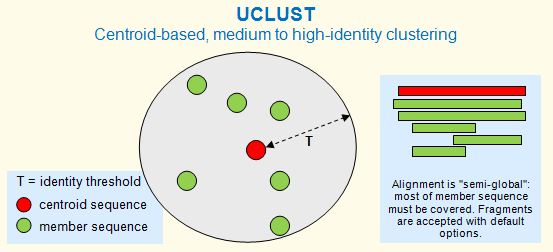|
See also
Dereplication
OTU clustering
UCLUST sort order
Consensus sequences
Natural centroids and recentering
The UCLUST algorithm divides a set of sequences into clusters. The
cluster_fast and cluster_smallmem commands are based on
UCLUST. A cluster is defined by one sequence, known as the centroid
or representative sequence. Every sequence in the cluster must have
similarity above a given identity
threshold with the centroid, as shown in the figure below. In
previous versions centroids were called seed sequences; this term
is no longer used to avoid confusion with alignment seeds (matching
words) in algorithms such as BLAST and UBLAST. The identity threshold (T) can be
viewed as the radius of a cluster. Clustering commands include
cluster_fast and cluister_smallmem.

Clustering and
identity
The definition of
identity changed in USEARCH version 6. This sometimes results
in an increased number of clusters
at a given identity threshold, but this should not be interpreted
as reduced sensitivity or worse cluster quality.
Recommended identity
ranges
UCLUST is effective at identities of ~50% and above for proteins and ~75%
and above for nucleotides. At lower identities, this type of
method is questionable because (i) alignment quality degrades and
(ii) homology cannot be reliably determined from an alignment.
Clustering
criteria
UCLUST is designed to find a set of clusters such
that:
(1) All centroids have
similarity < T to each other, and
(2) All member sequences have similarity >= T to a
centroid.
With default parameters, the
algorithm is heuristic and condition (1) is not guaranteed to hold,
though in practice false negatives (two centroids with similarity
>= T) are rare. Note that in general, many different clusterings
will satisfy these criteria. For example, a sequence may match two
different centroids with identity > T. Ideally, it will be
assigned to the closest centroid, but there may be two or more at
same distance, in which case the best cluster assignment is ambiguous and an
arbitrary choice must be made.
Identities are computed using
a global alignment. Clustering based on local alignments could
easily be implemented in the USEARCH software, but I believe
local clustering is fundamentally
flawed. If you have a application that really needs it, I'll
add support for local clustering.
Input sequence
order
UCLUST is a
greedy algorithm, and the order of the
input sequences is important. In the cluister_smallmem command, sequences
are processed in the order they appear in the input file. If the
next sequence matches an existing centroid, it is assigned to that
cluster, otherwise it becomes the centroid of a new cluster. This
means that sequences should be ordered so that the most appropriate
centroids tend to appear earlier in the file. The best order
depends on the application; see UCLUST sort
order for further discussion. The cluster_fast
command can use the input sequence order (this is the default), or can sort by
sequence length or by size annotation by
specifying -sort length or -sort size, respectively..
Searching the centroid
database
A fundamental step in UCLUST is to compare
an input sequence with the centroids identified so far. This
is done using the USEARCH
algorithm. Most USEARCH parameters, including indexing options, can be used with
clustering commands in order to control sensitivity, memory use and
speed.
Clustering
fragments
If both full-length sequences and fragments are
present in the input, then sorting sequences by decreasing length
is effective (see sort order, sortbylength). Fragments usually make poor
centroids because two full-length sequences may be similar to a
fragment over one segment while being more diverged over the rest
of their length. If the fragment is a centroid, this could result
in highly divergent full-length sequences being assigned to the
same cluster.
OTU clustering
Clustering sequences into Operational Taxonomic Units (OTUs) is a
specialized problem. A length sort is not appropriate as this tends
to choose centroids that are biological outliers, splitting species
and genera into different clusters and inflating alpha diversity.
See OTU clustering for a recommended procedure
for creating OTUs with USEARCH.
Reference
Edgar,
R.C. (2010) Search and clustering orders of magnitude faster than
BLAST, Bioinformatics 26(19), 2460-2461.
doi:
10.1093/bioinformatics/btq461
|
